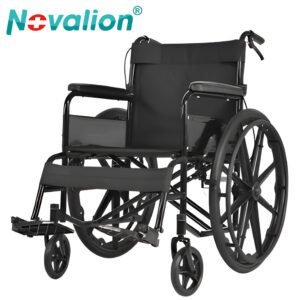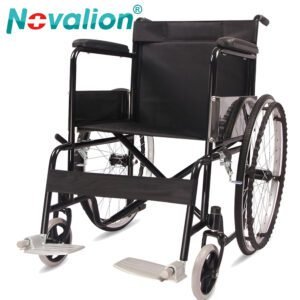High Back Wheelchair with Head Support: 5 Key Questions Answered—From Support Features to User Fit & Daily Use
For users with neck weakness, poor posture control, or neurological conditions, a standard wheelchair’s backrest and lack of head support can lead to pain, fatigue, or even injury. A high back wheelchair with head support is engineered to solve this: it stabilizes the entire torso and cradle the head, turning passive sitting into active posture support. But what makes this design unique, who needs it, and how do you choose the right one? Here are 5 critical questions answered.
1. What Defines a High Back Wheelchair with Head Support?
This specialized wheelchair combines an extended backrest with a dedicated headrest, targeting users who need full spinal and neck stabilization. Key traits include:
- High Back Design: Backrest height of 20–26 inches (taller than standard high back wheelchairs, which top out at 18–20 inches). This supports the upper back, shoulders, and even the base of the neck.
- Integrated Head Support: A padded headrest (not just an add-on) attached to the backrest, adjustable in height (3–6 inches), angle (0°–30°), and depth (to match head size). It prevents the head from drooping forward or sideways.
- Key Difference from Standard High Back Wheelchairs: Standard high back models focus on upper back support but lack dedicated headrests. This design adds targeted neck stabilization, critical for users with weak neck muscles.
2. Key Features of Its Support System
The effectiveness lies in how the high back and head support work together:
- Adjustable Headrest: Most feature a padded, contoured headrest that tilts forward/backward (to align with the natural curve of the neck) and slides up/down (to match user height—e.g., 5’2” vs. 6’0”). Some even pivot sideways for users with uneven muscle tone (e.g., cerebral palsy).
- Lumbar Support: A built-in lower back cushion (adjustable in firmness) prevents the spine from slouching, ensuring the upper back and head stay aligned.
- Recline/Tilt Functions: Many models recline (backrest moves) or tilt (entire seat tilts) to 140°–160°. This adjusts head support in sync with the back, maintaining natural neck alignment even when the user is semi-reclined.
- Frame Stability: Sturdy steel or reinforced aluminum frames prevent wobbling, even when the user shifts weight or the chair is reclined—critical for safety when head support is in use.
3. Who Benefits Most from This Wheelchair?
It’s life-changing for users with conditions that affect posture and neck control:
- Spinal Cord Injuries (SCI): Users with cervical SCI (neck-level injuries) often have weak neck muscles; the headrest prevents dangerous drooping that could restrict breathing.
- Neurological Conditions: Cerebral palsy, MS, or Parkinson’s can cause muscle stiffness or weakness, making it hard to hold the head up. The headrest reduces fatigue and risk of falls.
- Stroke Survivors: Those with hemiplegia (one-sided weakness) may lean to one side; the high back and headrest correct alignment and prevent injury.
- Post-Surgery Recovery: Patients recovering from neck or spinal surgery need controlled alignment to avoid straining healing tissues.
4. How It Performs in Daily Use
Its design shines in real-world scenarios where posture matters most:
- Long Sits (6+ Hours): The headrest and high back distribute weight across the entire torso, reducing pressure on the neck and upper back. Users report less fatigue compared to standard wheelchairs.
- Home & Public Spaces: Narrow frames (24–28 inches wide) fit through doorways, while smooth-rolling casters navigate tight spaces (e.g., kitchens, doctor’s offices). The headrest doesn’t block visibility, so users can interact normally.
- Caregiver Tasks: Recline/tilt functions simplify transfers (e.g., from wheelchair to bed) and personal care (bathing, dressing), as the user’s head and back stay supported without manual holding.
5. What to Prioritize When Buying
- Headrest Adjustability: Ensure it aligns with the user’s neck—too high/low causes strain. Look for 3+ inches of height adjustment and 15°+ of tilt.
- Recline/Tilt Compatibility: The headrest should move in sync with the backrest. Avoid models where reclining shifts the headrest out of alignment.
- Comfort Materials: Breathable mesh or moisture-wicking fabric (prevents sweating during long sits) and a padded headrest (1–2 inches thick) to avoid pressure on the skull.
- Safety Checks: Anti-tip bars (critical for reclined positions), secure wheel locks, and a weight capacity 50+ lbs higher than the user’s weight (to account for head/back support added weight).
Conclusion
A high back wheelchair with head support isn’t just about “extra padding”—it’s a medical tool that stabilizes the body, reduces fatigue, and prevents injury for users with posture challenges. By prioritizing adjustability, alignment, and safety, you’ll find a model that turns sitting from a struggle into a foundation for daily independence.
Thank you for reading this, dear, if you have any suggestions about our website or want to know about wheelchair, please contact us. We will respond quickly.



